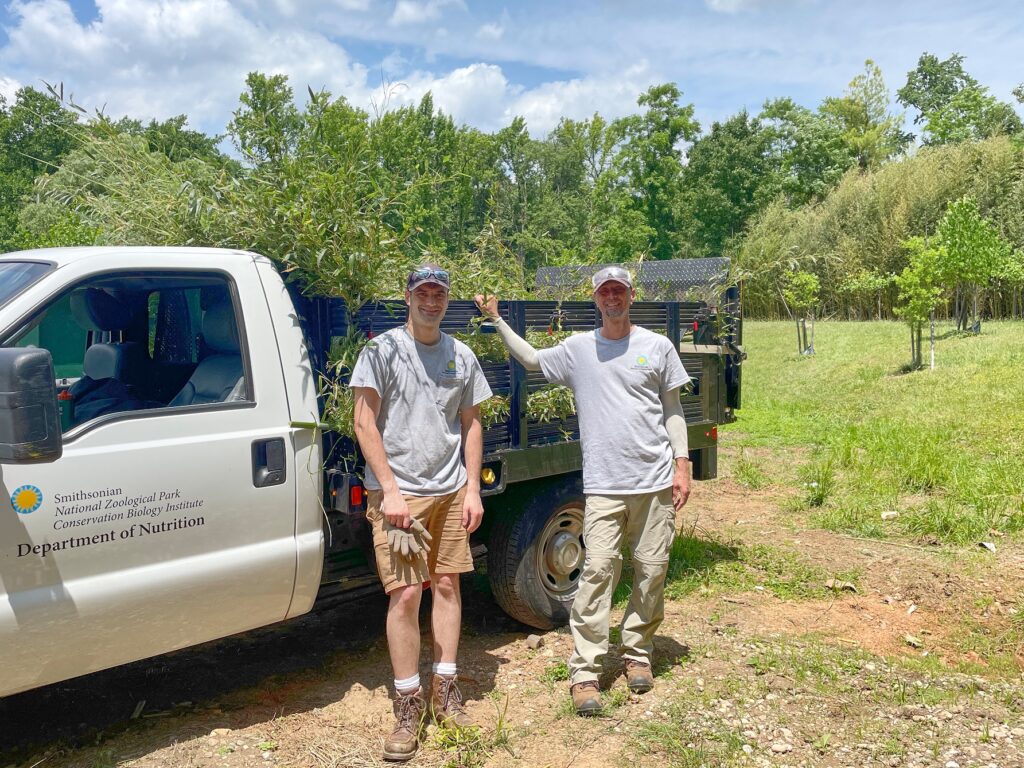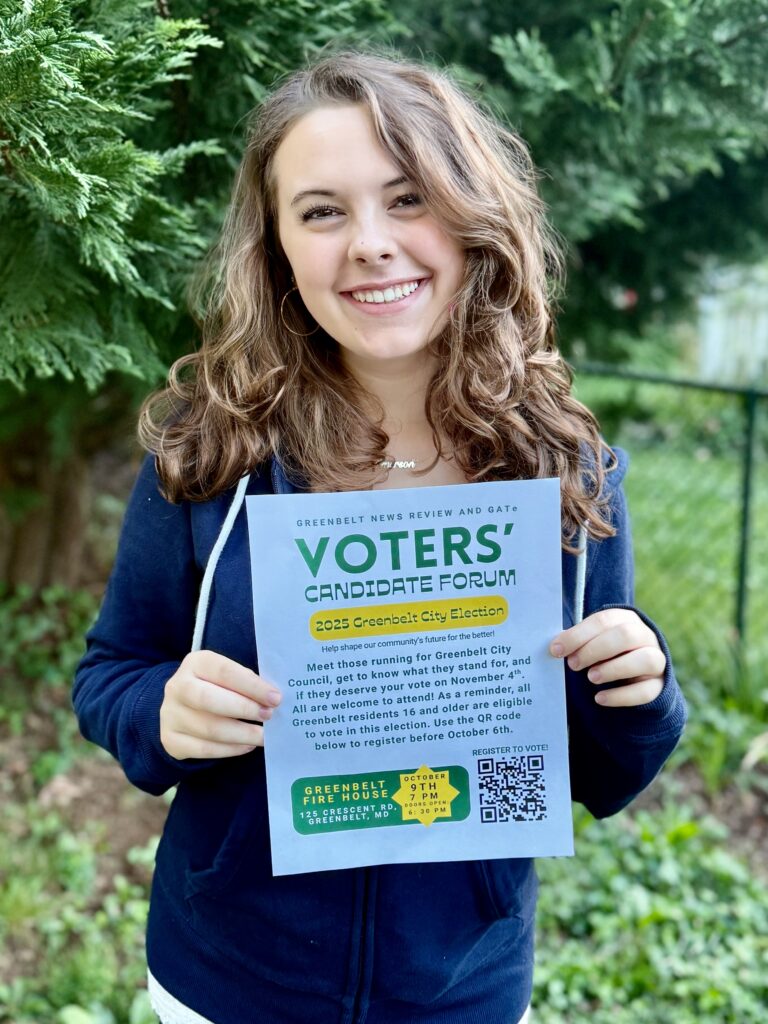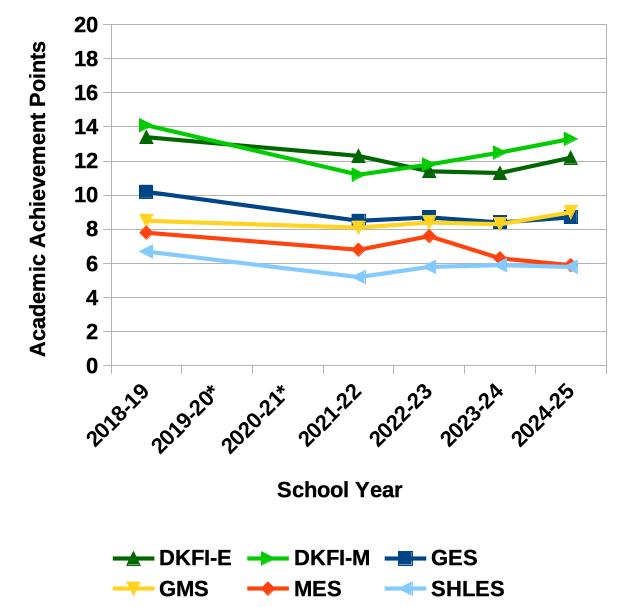The next time you visit the elephants at the Smithsonian’s National Zoo in Washington, D.C., they might be eating bamboo from Greenbelt. As a new Greenbelter who has joined others across the city in removing bamboo – an aggressive, non-native invasive plant that deprives other plants and wildlife of the space and nutrients they need – I wondered if the Smithsonian’s National Zoo and Conservation Biology Institute (NZCBI), might be interested in harvesting it. Based on my work with the Smithsonian I learned that they manage, grow and harvest bamboo to feed the Asian animals in their care, including giant pandas, red pandas and Asian elephants.
After I reached out to the Zoo’s Department of Nutrition Science, they came to Greenbelt, in May, to assess the bamboo thickets. Kevin Carpenter-Driscoll, environmental coordinator in the City of Greenbelt Department of Public Works, and Ben Fischler, chair of the Greenbelt Homes, Inc. (GHI) Woodlands Committee, gave us a tour of the bamboo locations. We went from one thicket to another, where the bamboo was evaluated based on health and species (pandas are picky eaters), as well as the ease of access and density of the growth for harvesting.
Thanks to the hard work by so many volunteers in our community, bamboo in many of the thickets has been eradicated or controlled to the point that the Zoo couldn’t use it – but finally, success! The Smithsonian team identified two robust, easy-to-access locations for harvest. On June 13, NZCBI completed the first harvest of bamboo from the area. They will harvest from these sites several times over the next couple of years. The result will be bamboo thickets that are thinned enough for our community of volunteers to prevent regrowth for a few more years, and then add native plants and begin restoring the ecosystem for the wildlife living in our area.
When I moved to Greenbelt, I quickly learned about the challenging work being done by our residents, the GHI Maintenance Department and the City of Greenbelt Public Works Department to remove or at least manage the bamboo in our community. Over the years, these intrepid individuals have mapped bamboo thickets, become official caretakers of GHI woodland parcels and organized work parties, educated people about the problems bamboo causes and identified alternative plants to replace it.
Bamboo, the largest member of the plant family of grasses called Poaceae, is native to the tropical areas of the Asia-Pacific region, South and Central America and parts of Africa and Australia. Three species from the genus Arundinaria are native to the Southeastern U.S. – A. appalachiana, A. gigantea and A. tecta. Within an ecosystem the plants and animals have evolved to support each other. In Asia, some species of animals specialize in eating bamboo thereby controlling its spread. The most well-known bamboo-eating animal is the giant panda, but the red panda, Asian elephant and other mammals also eat it.
Over the decades, several species of bamboo were planted in Greenbelt. Large stands of bamboo exist throughout Greenbelt and homeowners are encouraged to eradicate it through cutting, mowing and tarping. Scores of Greenbelt volunteers, working alone and in groups organized through various committees, have aggressively reduced bamboo growth. Partnering with the Smithsonian’s National Zoo is just one more way for us to combat this non-native invasive plant.
But that’s not the end of the story here in Greenbelt. The bamboo harvest results in some parts not used by the Zoo. The discarded cut bamboo left near the harvest sites is great for creating garden structures like supports for vegetable vines. Another byproduct of the harvest is compost. The Smithsonian composts the dung from the elephants, giant pandas and other vegetarian animals using high heat methods, turning it into a soil amendment used throughout the Smithsonian’s gardens. They also offer it to Smithsonian employees each year to celebrate Earth Day. Eventually some of the bamboo harvested from the thickets in Greenbelt might come back to us as compost to nurture native plants in the community.
What part of this project surprised me the most? I thought I would quietly make this connection to supply some food to the animals evolved to eat bamboo while helping remove it from Greenbelt. I never thought there would be so much excitement and support for this project. It’s a great reminder that together we can find creative ways to remove invasive plants and restore Greenbelt’s native ecosystem.
Kristen Bullard lives in GHI and is a member of the GHI Woodlands Committee and the City of Greenbelt Pollinator Circle. She has worked for the Smithsonian for 11 years.




